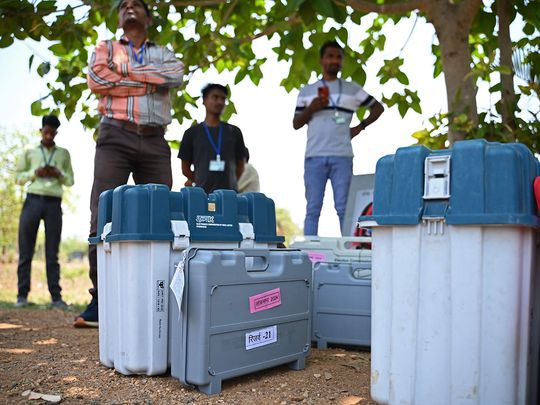
There is clearly a lack of enthusiasm among voters in India’s ongoing general election. This absence of gusto is seen not only in lower voter turnouts than last time but is also discernible on the streets.
‘There is no wave,’ we hear from various quarters. This is leading many hopeful opposition leaders and liberal-minded intellectuals to wonder if the ruling Bharatiya Janata Party (BJP) is going to suffer a surprise upset.
The absence of perceptible voter enthusiasm is not the same as the presence of anti-incumbency, let alone anger. For any ruling party to be completely voted out, there has to be perceptible sentiment of ‘change’ in society. For example, the Karnataka assembly elections last year had such a sense. Change was in the air.
Sometimes you can smell an election wave in the air — the famed “hawa”, the direction of the wind in Indian elections. But sometimes election waves are felt only in the results, not in the campaign.
Of village and nation
Another unexpected aspect of this election is in the form of reports of local factors becoming more important than the personality of Prime Minister Narendra Modi.
Local issues — caste, community, candidates — are always a factor but in various seats in various states, anecdotal reports suggest that the local is overcoming the national. Part of PM Modi’s success in 2014 and 2019 had been to make the national sentiment dominant over the local.
The extent to which this localisation is taking place will have to be seen in both vote shares and results. For now, it seems that even if the BJP is making incremental losses in its stronghold areas, it may make up for them in incremental gains in new states.
So if the BJP is losing a handful of seats in Rajasthan, Haryana or Karnataka, it is likely to make up for such potential losses with minor gains in Odisha and Telanaga, and possibly Andhra Pradesh, Tamil Nadu and West Bengal as well. In other words, we are looking at status quo. This should give the BJP more or less the same number of seats as last time.
One reason why the disenchantment of powerful caste groups should be taken with a pinch of salt is that they may alone not be enough to make the BJP lose seats. We may recall reports of Jats in western UP being unhappy with the BJP in the 2017 Uttar Pradesh assembly elections.
The reports were not wrong, yet the BJP swept the area completely. The BJP’s consolidation of small, fragmented lower caste communities gives it enough room to survive the anger of dominant, vocal caste groups.
All quiet at the polling booth
Nevertheless, what explains this lack of enthusiasm?
One is the sense of status quo. People are charged up for or against change. But a dominant BJP and a weak opposition leave little room for change.
Hopeful opponents of the BJP are presuming the lower voter turnout is because complacent BJP voters are not stepping out of their homes because they know their party is winning anyway. But it is equally, if not more, likely that disillusioned opposition voters are choosing to stay at home: what’s the point if the BJP is winning anyway?
In 2014, the Modi polarisation — for and against — was behind the street enthusiasm. In 2019, it was both Balakot and PM-Kisan, one a skirmish with Pakistan and the other cash transfers to small farmers. Both happened just before the elections.
This time, no big theme
It cannot be denied that the lack of enthusiasm this election is also because the BJP campaign has been poor. There are no big promises, no catchy slogan to appeal to the swing voter, no big theme. The only slogan that caught attention — “Abki baar 400 paar (More than 400 seats this time) — had to be dropped because it backfired with some fearing the BJP wants a brute majority to amend the Constitution.
The BJP became overconfident about the impact of the Ram Mandir inauguration in January, whose effect has fizzled out. We are now in May. Public memory lasts at most three months.
Balakot appealed to Indian nationalism, whose catchment area is much larger than Hindu nationalism. Efforts to appeal to nationalist sentiment are not charging up people — the G20 summit is now a nine-month-old event.
This is why they have had to take to fearmongering about the Congress party’s (imagined) plans to redistribute wealth to exclusively help minorities.
The freebies that didn’t come
In Modi’s first term, there were a number of tangible, material welfare benefits. These included toilets, housing, a free health insurance scheme for the poor, free gas cylinders with subsidised refills, cash transfers for small farmers and maybe some more.
In Modi’s second term, marked by Covid management and increased spending on infrastructure, there have hardly been any big-ticket new schemes. There is a scheme to provide tap water in poor households, but it has failed to bring political credit even where the scheme has succeeded.
The only scheme that stands out is free food grains to 800 million people — but these were heavily subsidised anyway. A poor family now saves about Rs500 a month with this scheme. That’s hardly enough for enthusiasm.
The election-year “interim” budget didn’t have a single election-centric announcement, surprising political observers. It spoke of political confidence, but that is also showing up in the lack of enthusiasm.
Yet this doesn’t mean the BJP is losing. The economic disenchantment is not a harvest for the opposition due to its own structural weaknesses, lack of ground workers, disparity in campaign finance, a hostile media and so on.









